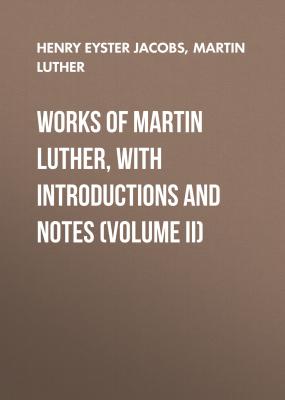Works of Martin Luther, with Introductions and Notes (Volume II). Martin Luther
Читать онлайн.| Название | Works of Martin Luther, with Introductions and Notes (Volume II) |
|---|---|
| Автор произведения | Martin Luther |
| Жанр | Философия |
| Серия | |
| Издательство | Философия |
| Год выпуска | 0 |
| isbn |
274
The three kinds of masses are really but one thing, viz., masses for the dead, celebrated on certain fixed days in each year, in consideration of the enjoyment of certain incomes, received either out of bequeathed endowments or from the heirs of the supposed beneficiaries.
275
i. e., Even when the mass is decently said.
276
See above, p. 72, note 1.
277
See above, p. 104.
278
279
The
280
i. e., To those who teach and enforce the canon law.
281
Luther means the saint's-days and minor religious holidays. See also the
282
Or "congregation."
283
i. e., City-council.
284
285
i. e., Occasions for drunkenness, gain and gambling.
286
See above, pp. 96 f.
287
See above, p. 98, note 2.
288
Letters entitling their holder to the benefits of the masses founded by the sodalities or confraternities. See Benrath, p. 103.
289
See above, p. 98, and Vol. I, p. 22.
290
The pun is untranslatable,—
291
What the pope sold was release from the "snares" and "nets," viz., dispensation.
292
i. e., Even into the law of the church.
293
294
A little town in East Prussia, where was displayed a sacramental wafer, said to have been miraculously preserved from a fire which destroyed the church in 1383. It was alleged that at certain times this wafer exuded drops of blood, reverenced as the blood of Christ, and many miracles were said to have been performed by it. Wilsnack early became a favorite resort for pilgrims. In 1412 the archbishop of Prague, at the instigation of John Hus, forbade the Bohemians to go there. Despite the protests of the Universities of Leipzig and Erfurt, Pope Eugenius IV in 1446 granted special indulgences for this pilgrimage, and the popularity of the shrine was undiminished until the time of the Reformation. Cf.
295
In Mecklenburg, where another relic of "the Holy Blood" was displayed after 1491. C. Benrath, pp. 104 f.
296
The "Holy Coat of Trier" was believed by the credulous to be the seamless coat of Christ, which the soldiers did not rend. It was first exhibited in 1512, but was said to have been presented to the cathedral church of Trier by the Empress Helena, mother of Constantine the Great.
297
Pilgrimage to the Grimmenthal in Meiningen began in 1499. An image of the Virgin, declared to have been miraculously created, was displayed there, and was alleged to work wonderful cures, especially of syphilis.
298
The "Fair Virgin (
299
The pilgrimages were a source of large revenue, derived from the sale of medals which were worn as amulets, the fees for masses at the shrines, and the free-will offerings of the pilgrims. A large part of this revenue accrued to the bishop of the diocese, though the popes never overlooked the profits which the sale of indulgences or worship at these shrines could produce. In the
300
i. e., Every bishop.
301
The possession of a saint gave a church a certain reputation and distinction, which was sufficiently coveted to make local Church authorities willing to pay roundly for the canonisation of a departed bishop or other local dignitary. Cf. Hutten's
302
Archbishop of Florence (died 1450). He was canonised, May 31, 1523, by Pope Hadrian VI. When Luther wrote this the process of canonisation had already begun.
303
304
"Lead," the leaden seal attached to the bull; "hide", the parchment on which it is written; "the string," the ribbon or silken cord from which the seals depend; "wax," the seal holding the cord to the parchment.
305
Franciscans, Dominicans, Augustinians, Carmelites and Servites.
306
307
